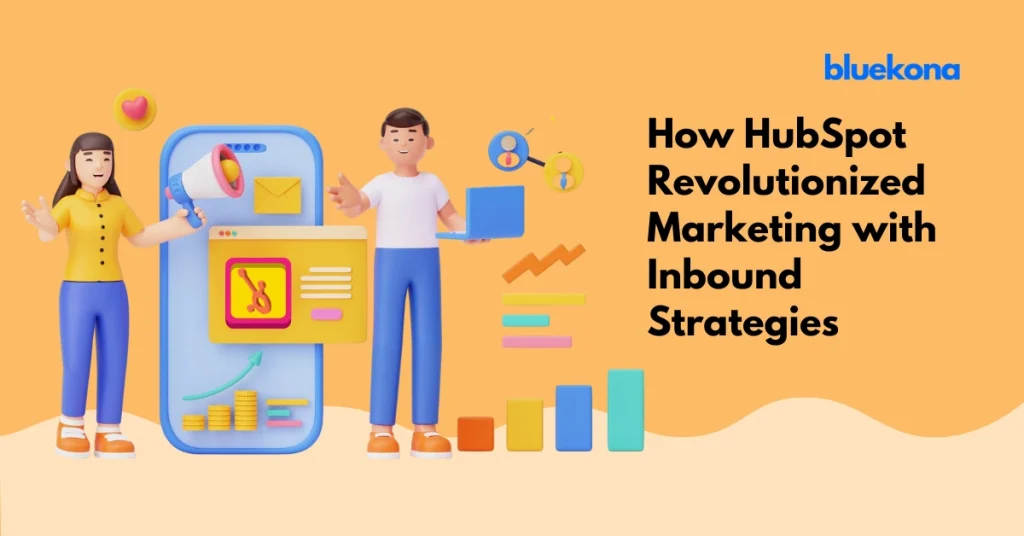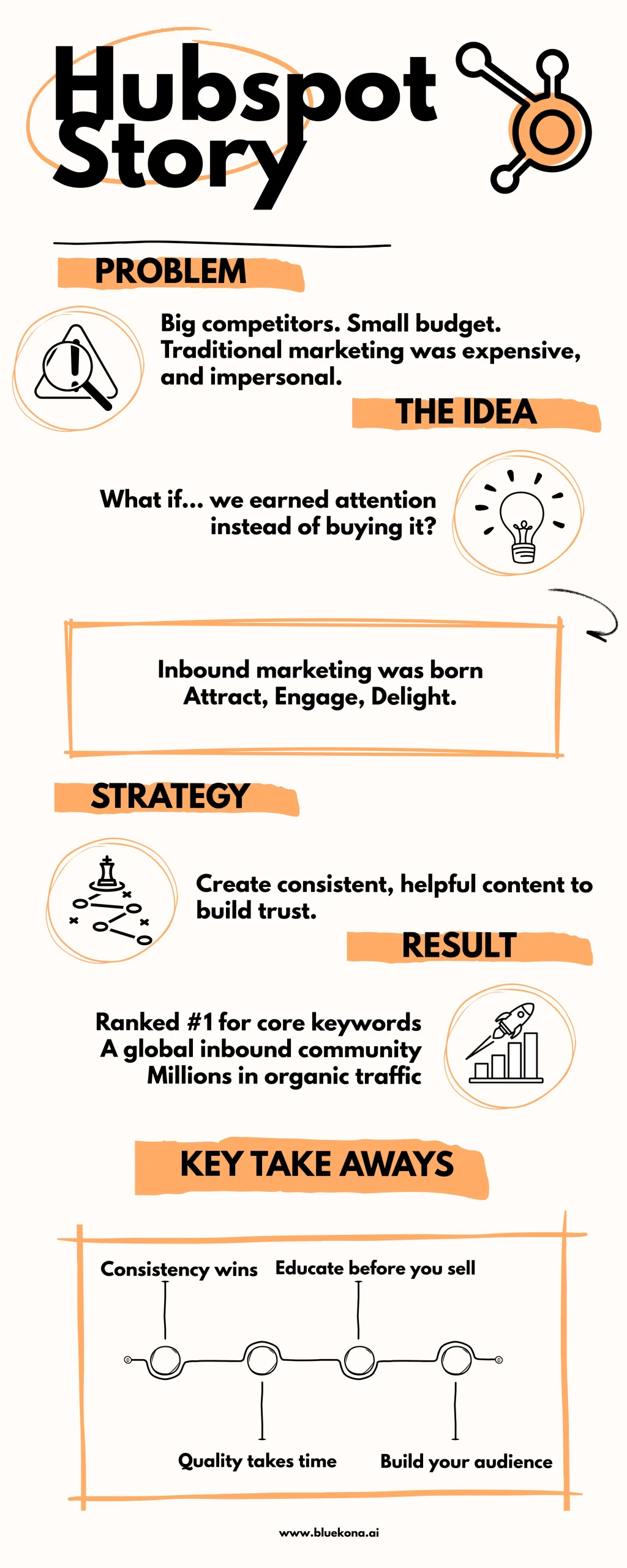
In a digital world overflowing with ads, pop-ups, and cold outreach, one company rewrote the rules of marketing—and turned content into a growth engine.
HubSpot didn’t just adopt content marketing — they helped define it, championing a new approach that prioritized value over volume, education over interruption.
Inbound marketing—a strategy built on attracting customers through helpful, relevant content rather than chasing them with traditional ads.
Let’s explore how HubSpot’s bold bet on inbound transformed them from a startup into a marketing powerhouse, setting the gold standard for content-driven growth.
Content marketing is more than just publishing blog posts—it’s a strategic approach to creating and distributing valuable, relevant, and consistent content to attract and retain a clearly defined audience.
Instead of pushing products, it pulls people in with information they actually want.
In today’s digital landscape, where attention is scarce and trust is earned, content marketing has become essential. It builds credibility, nurtures relationships, and helps brands stay top-of-mind long before a purchase decision is made.
For modern marketers, it’s not just a tactic—it’s a foundation.
As the internet reshaped how people discover and engage with brands, a shift was brewing. Traditional outbound tactics like cold calls, display ads, email blasts—were losing their edge.
Audiences had more control, more choices, and higher expectations.
Enter inbound marketing: a customer-centric methodology focused on attracting people through helpful, relevant content instead of interruptive messages.
Rather than chasing customers, inbound lets them come to you—when they’re ready, and on their terms.
HubSpot didn’t just embrace this idea—they built a movement around it. By positioning themselves as the champions of inbound marketing, they not only defined a new way of thinking but also created a category they could lead.
This laid the groundwork for their rise as one of the most influential voices in modern marketing.
To understand HubSpot’s impact on the marketing world, it’s essential to start at the beginning—with a bold vision, a timely insight, and two founders who believed the old way of marketing was broken.
HubSpot was founded in 2006 by Brian Halligan and Dharmesh Shah, who met at MIT. The duo observed a fundamental shift in consumer behavior — people were tuning out traditional marketing and seeking out their own information before making decisions.
Halligan and Shah saw an opportunity. What if businesses could stop interrupting and start attracting? Their idea was simple but revolutionary. This helped companies grow by aligning their marketing with how people actually want to buy.
HubSpot’s first product was a marketing automation platform designed to give small and mid-sized businesses the same tools larger enterprises used— but easier, more affordable, and focused on content-led growth.
From the beginning, the product supported a new philosophy: attract, convert, close, and delight customers with useful content and personalized experiences. It wasn’t just software—it was a new system of thinking.

Despite a promising idea and a clear market need, HubSpot’s path to success wasn’t without hurdles. As a young startup entering a crowded space dominated by giants, the company faced significant challenges that shaped its bold content-first strategy.
At the time, Salesforce was the undisputed leader in CRM and marketing software. With deep pockets and established brand recognition, Salesforce set the standard—and made it incredibly hard for newcomers to stand out.
HubSpot couldn’t outspend Salesforce on advertising or salesforce manpower. Instead, they needed to outthink them—by becoming more relevant, more helpful, and more discoverable to their ideal customer.
Like many startups, HubSpot operated on tight budgets and lean teams. This meant traditional outbound tactics—TV ads, trade shows, cold outreach—were out of the question.
To grow efficiently, they needed a strategy that was:
The solution? Inbound marketing. A playbook that didn’t rely on paid reach—but on building long-term trust through content.
Faced with larger competitors and limited resources, HubSpot didn’t just adopt inbound marketing — they defined it. The team built a strategy rooted in one powerful idea: instead of pushing products, pull people in with helpful, relevant content.
HubSpot coined inbound marketing as a methodology focused on:

Rather than interrupting with ads, inbound marketers create content that:
It’s marketing that feels more like a service than a pitch.
Inbound wasn’t just a buzzword—it was a strategic answer to the real challenges HubSpot faced:
Inbound gave HubSpot a way to own its visibility without renting attention through ads.
To draw in the right audience, HubSpot leaned heavily on:
Every piece of content acted as a magnet, bringing prospects into their world.
Once in the funnel, HubSpot used email nurturing, gated assets (like ebooks and templates), and marketing automation to:
It wasn’t just about leads—it was about building lasting relationships.
A great strategy means nothing without consistent, high-quality execution — and HubSpot nailed it. They turned their inbound vision into reality by building a content engine that delivered massive value, day after day.
HubSpot didn’t rely on just one format. They created a library of resources that met prospects at every stage of the funnel.
Their blog became the heartbeat of the strategy:
The result? HubSpot ranked for thousands of high-intent keywords and became a go-to source in the industry.
Deep dives turned blog visitors into leads:
These weren’t fluff — they were full-on guides, often downloaded and shared across teams.
HubSpot understood the power of tools over tips:
By giving marketers resources they could actually use, HubSpot encouraged downloads, sharing, and bookmarking.
Webinars added a real-time, human touch:
They weren’t just selling — they were helping people do their jobs better.
Creating content was only half the battle — HubSpot built smart distribution systems to ensure their content reached the right people:
Their strategy wasn’t just “write it and they will come.” It was: write it, share it everywhere, and optimize constantly.
HubSpot treated content like a product:
This wasn’t random content creation. It was a well-oiled system built for scale.
HubSpot’s inbound marketing strategy didn’t just look good on paper — it delivered real, measurable results that transformed the company from a scrappy startup into an industry-defining powerhouse. SEO Dominance
Thanks to consistent, SEO-optimized content, HubSpot quickly rose through the search rankings:
By owning marketing-related search intent, HubSpot positioned itself as the trusted authority.
HubSpot didn’t just market — it built a movement around inbound:
Inbound wasn’t just a strategy — it became a shared identity among modern marketers.
The numbers speak for themselves:
All this, largely powered by content — not just ads.
HubSpot’s journey with inbound marketing wasn’t without bumps. Their success was built on experimentation, iteration, and long-term commitment. Here’s what they learned along the way:
At the start, HubSpot focused on volume. The result?
They quickly pivoted to emphasize value and depth, setting editorial standards and investing in content expertise.
Lesson: It’s not enough to publish often — quality builds trust.
Inbound wasn’t a quick fix:
But over time, the flywheel effect kicked in — content began driving exponential returns.
Lesson: Organic marketing rewards consistency, not instant gratification.
Here’s what marketers can steal from HubSpot’s playbook:
HubSpot didn’t win by outspending competitors — they out-taught them.
HubSpot’s rise from startup to SaaS powerhouse didn’t hinge on a massive ad budget — it came from mastering the long game of content.
By pioneering inbound marketing, they not only attracted millions of users but also reshaped how brands think about growth. Their strategy proved that with the right mix of education, value, and consistency, companies can build momentum that doesn’t stop when ad spend does.
For modern marketers, the takeaway is clear: if you want lasting impact, stop renting attention and start building your own. Whether you’re a solopreneur or scaling a team, content is still your most scalable asset.

Dec 19, 2025Anjana Devi
78% people prefer learning about products through video but the catch is only 31% will finish a poorly-edited one. The rest? Gone — swiping to your competitor, clicking away, or worse, teaching the algorithm your content isn’t worth surfacing. Editing is no longer about looking slick. It’s about being seen, shared, and searched. The SMBs […]

Dec 12, 2025Anjana Devi
Most brands try to buy attention. Gymshark built a $1.45B empire by earning it. Founded in 2012 in a garage by teenager Ben Francis, Gymshark didn’t win by outspending Nike or Adidas. They won by out-creating them—turning influencers into athletes, community into currency, and content into the engine of compounding growth. Paid ads? They used […]

Dec 5, 2025Anjana Devi
“Post consistently! Be authentic! Engage more!” If I had a dollar every time someone lobbed that cookie-cutter advice at struggling creators, I’d have enough to buy Twitter back from Elon. The problem isn’t that it’s wrong—it’s just about as useful as telling someone to “be yourself” on a first date. Like, thanks, but what does […]